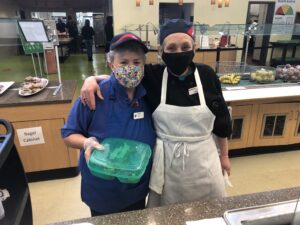Huden’s options: To stay or to go

Huden Dining Hall had to change its food delivery process when the pandemic hit over a year ago.
These changes include new safety guidelines like wearing a mask, socially distanced seating, wrapping fruit and bagels to limit germ exposure, and changing from buffet style to someone serving you a plate.
Huden took these changes a step further by offering a to-go option for meals.
Instead of eating your meal at the dining hall, students can ask for a compostable to-go box, which is available to students and staff who struggle to find a seat due to limited seating or prefer to eat their meal in their dorm.
But it might surprise some of you that to-go boxes are not new to Huden.
In fall 2012, Huden started a program allowing students to purchase a green plastic to-go container. The container costs $25. This fee includes a one-time $5 payment and an annual $20 deposit students get back when they return the container at the end of the year, broken or intact.
Many students have different opinions about Huden’s current take-out options ranging from cost to eco-friendliness.
“I don’t think students should have to pay to get food to-go from Huden when we pay a lot for a meal plan every semester,” said junior Alex Benfatti.
But the head of Huden Dining Hall said there’s a reason for the deposit.
“My first year running this program, we gave out around 200 containers and by the end of the year, we received maybe four back,” said Huden’s Rob Macfarlane chuckling.
Macfarlane is the general manager of Sodexo at Castleton and has been working with Sodexo for 21 years throughout the New England region.
He explained the purpose of purchasing the container and putting a deposit down is not to make a profit. The containers themselves cost $5. The deposit you get back in cash at the end of the year is to make sure you return the container. Macfarlane emphasized Sodexo makes no profit on this program saying it’s purely for the students.
Some students like Junior Dylan Toomey find the current system handy.
“It’s very helpful right now because a lot of times, I get hungry quick again after Huden closes,” he said.
Macfarlane wants to inform the student body the main reason students weren’t allowed to take food out of the dining hall pre-pandemic and will not be able to post-pandemic without a green container is food safety.
“Imagine a student takes a tuna fish sandwich and throws it in their bag running to class. They might not even eat the sandwich until hours later. A tuna sandwich needs to be eaten within an hour unrefrigerated or you drastically increase the risk of food illness. If the student eats the sandwich and gets sick, it looks bad on us,” Macfarlane said.
Macfarlane continued to explain how it’s his and his staff’s job to care for the student’s well- being on campus and the green to-go container is the best way to keep track of what leaves the dining hall. Before a student receives their container, Macfarlane will go over and explain food safety with the student.
When a student brings in the container, Huden staff will clean it. Once clean, students can fill their container up and leave.
Macfarlane is relieved and confident knowing the students have a clean container and the proper education about food safety to continue to run this program.
But some students, like Junior Callie Miltenberger, aren’t sure it’s working like Huden officials hope.
“The to-go boxes we have now [are] a waste because the hope was that they’d be recycled, but I’m sure 99% of the students just throw them away,” she said.
Junior Olivia Perry agrees.
“The compostable ones being used at Huden and the plastic containers given to those in quarantine and isolation are bad for the environment,” she said.
Huden staff and campus administration were thinking about the environment when making these decisions and promise they won’t be permanent.
“When it came to picking what we were going to use for to-go containers, I selected the compostable ones over Styrofoam because I believe that Styrofoam would go against what we are trying to do here environmentally at Castleton,” Macfarlane said.
For quarantine and isolation buildings on campus, plastic containers are being used to deliver food. Macfarlane explained he intentionally chose this option because it keeps the food hot, and any wet food won’t seep through the container like it would in the compostable containers.
He knows this isn’t the best for waste or the environment, but the goal is to keep the food safe. He also hopes students are following protocols put into place on campus and through the state of Vermont to reduce the number of people he and his staff have to deliver to in these buildings.
The great news is Huden’s to-go option will continue next semester although you won’t see compostable containers next year. The program will be going under some kind of revision to be discussed over the summer. The green plastic containers will remain in the fall, and Macfarlane encourages students to take advantage of this program.
He also recommends that student-athletes purchase these containers or have their programs purchase them.
“It’s easy for my staff to fire up a grill at 8 a.m. before they have to catch a bus, and these containers are perfect for that,” he said.







